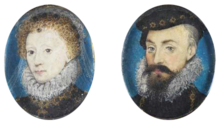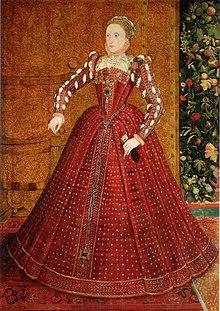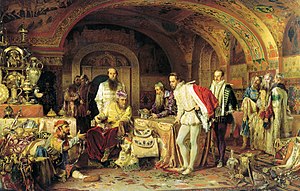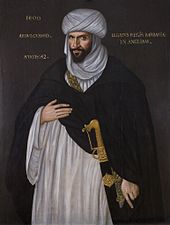
Elizabeth and her favourite, Robert Dudley, Earl of Leicester, c. 1575. Pair of stamp-sized miniatures by Nicholas Hilliard.[62] The Queen's friendship with Dudley lasted for over thirty years, until his death.
Lord Robert Dudley
In the spring of 1559 it became evident that Elizabeth was in love with her childhood friend Lord Robert Dudley.[66] It was said that Amy Robsart, his wife, was suffering from a "malady in one of her breasts", and that the Queen would like to marry Lord Robert in case his wife should die.[67] By the autumn of 1559 several foreign suitors were vying for Elizabeth's hand; their impatient envoys engaged in ever more scandalous talk and reported that a marriage with her favourite was not welcome in England:[68] "There is not a man who does not cry out on him and her with indignation ... she will marry none but the favoured Robert".[69] Amy Dudley died in September 1560 from a fall from a flight of stairs and, despite the coroner's inquest finding of accident, many people suspected Dudley to have arranged her death so that he could marry the queen.[70] Elizabeth seriously considered marrying Dudley for some time. However, William Cecil, Nicholas Throckmorton, and some conservative peers made their disapproval unmistakably clear.[71] There were even rumours that the nobility would rise if the marriage took place.[72]Despite several other marriage projects, Robert Dudley was regarded as a candidate for nearly another decade.[73] Elizabeth was extremely jealous of his affections, even when she no longer meant to marry him herself.[74] In 1564 Elizabeth created Dudley Earl of Leicester. He finally remarried in 1578, to which the queen reacted with repeated scenes of displeasure and lifelong hatred towards his wife.[75] Still, Dudley always "remained at the centre of [Elizabeth's] emotional life", as historian Susan Doran has described the situation.[76] He died shortly after the Armada, and after Elizabeth's own death, a note from him was found among her most personal belongings, marked "his last letter" in her handwriting.[77]
Political aspects

François, Duke of Anjou, by Nicholas Hilliard. Elizabeth called the duke her "frog", finding him "not so deformed" as she had been led to expect.[78]
Parliament repeatedly petitioned her to marry, but she always answered evasively.[84] In 1563, she told an imperial envoy: "If I follow the inclination of my nature, it is this: beggar-woman and single, far rather than queen and married".[79] In the same year, following Elizabeth's illness with smallpox, the succession question became a heated issue. Parliament urged the queen to marry or nominate an heir, to prevent a civil war upon her death. She refused to do either. In April, she prorogued the Parliament, which did not reconvene until she needed its support to raise taxes in 1566. The House of Commons threatened to withhold funds until she agreed to provide for the succession. The issue progressed and the House sent Sir Robert Bell, who 'did argue very boldly' to pursue the succession question; "in the face of the Queen's command to leave it alone". "In her own words 'Mr Bell with his complices... must needs prefer their speeches to the upper house to have you, my lords, consent with them, whereby you were seduced, and of simplicity did assent unto it'."[85] Later in that year, she confided to the Spanish ambassador that if she could find a way to settle the succession without marrying, she would do so. By 1570, senior figures in the government privately accepted that Elizabeth would never marry or name a successor. William Cecil was already seeking solutions to the succession problem.[79] For this stance, as for her failure to marry, she was often accused of irresponsibility.[86] Elizabeth's silence strengthened her own political security: she knew that if she named an heir, her throne would be vulnerable to a coup.[87]

The "Hampden" portrait, by Steven van der Meulen, ca. 1563. This is the earliest full-length portrait of the queen, made before the emergence of symbolic portraits representing the iconography of the "Virgin Queen".[88]
Mary, Queen of Scots
Elizabeth's first policy toward Scotland was to oppose the French presence there.[91] She feared that the French planned to invade England and put Mary, Queen of Scots, who was considered by many to be the heir to the English crown,[92] on the throne.[93] Elizabeth was persuaded to send a force into Scotland to aid the Protestant rebels, and though the campaign was inept, the resulting Treaty of Edinburgh of July 1560 removed the French threat in the north.[94] When Mary returned to Scotland in 1561 to take up the reins of power, the country had an established Protestant church and was run by a council of Protestant nobles supported by Elizabeth.[95] Mary refused to ratify the treaty.[96]In 1563 Elizabeth proposed her own suitor, Robert Dudley, as a husband for Mary, without asking either of the two people concerned. Both proved unenthusiastic,[97] and in 1565 Mary married Henry Stuart, Lord Darnley, who carried his own claim to the English throne. The marriage was the first of a series of errors of judgement by Mary that handed the victory to the Scottish Protestants and to Elizabeth. Darnley quickly became unpopular in Scotland and then infamous for presiding over the murder of Mary's Italian secretary David Rizzio. In February 1567, Darnley was murdered by conspirators almost certainly led by James Hepburn, Earl of Bothwell. Shortly afterwards, on 15 May 1567, Mary married Bothwell, arousing suspicions that she had been party to the murder of her husband. Elizabeth wrote to her:
How could a worse choice be made for your honour than in such haste to marry such a subject, who besides other and notorious lacks, public fame has charged with the murder of your late husband, besides the touching of yourself also in some part, though we trust in that behalf falsely.[98]These events led rapidly to Mary's defeat and imprisonment in Loch Leven Castle. The Scottish lords forced her to abdicate in favour of her son James, who had been born in June 1566. James was taken to Stirling Castle to be raised as a Protestant. Mary escaped from Loch Leven in 1568 but after another defeat fled across the border into England, where she had once been assured of support from Elizabeth. Elizabeth's first instinct was to restore her fellow monarch; but she and her council instead chose to play safe. Rather than risk returning Mary to Scotland with an English army or sending her to France and the Catholic enemies of England, they detained her in England, where she was imprisoned for the next nineteen years.[99]
Mary and the Catholic cause

Sir Francis Walsingham, Principal Secretary 1573–1590. Being Elizabeth's spymaster, he uncovered several plots against her life.
Regnans in Excelsis gave English Catholics a strong incentive to look to Mary Stuart as the true sovereign of England. Mary may not have been told of every Catholic plot to put her on the English throne, but from the Ridolfi Plot of 1571 (which caused Mary's suitor, the Duke of Norfolk, to lose his head) to the Babington Plot of 1586, Elizabeth's spymaster Sir Francis Walsingham and the royal council keenly assembled a case against her.[106] At first, Elizabeth resisted calls for Mary's death. By late 1586 she had been persuaded to sanction her trial and execution on the evidence of letters written during the Babington Plot.[107] Elizabeth's proclamation of the sentence announced that "the said Mary, pretending title to the same Crown, had compassed and imagined within the same realm divers things tending to the hurt, death and destruction of our royal person."[108] On 8 February 1587, Mary was beheaded at Fotheringhay Castle, Northamptonshire.[109]
Wars and overseas trade
Elizabeth's foreign policy was largely defensive. The exception was the English occupation of Le Havre from October 1562 to June 1563, which ended in failure when Elizabeth's Huguenot allies joined with the Catholics to retake the port. Elizabeth's intention had been to exchange Le Havre for Calais, lost to France in January 1558.[110] Only through the activities of her fleets did Elizabeth pursue an aggressive policy. This paid off in the war against Spain, 80% of which was fought at sea.[111] She knighted Francis Drake after his circumnavigation of the globe from 1577 to 1580, and he won fame for his raids on Spanish ports and fleets. An element of piracy and self-enrichment drove Elizabethan seafarers, over which the queen had little control.[112][113]Netherlands expedition
After the occupation and loss of Le Havre in 1562–1563, Elizabeth avoided military expeditions on the continent until 1585, when she sent an English army to aid the Protestant Dutch rebels against Philip II.[114] This followed the deaths in 1584 of the allies William the Silent, Prince of Orange, and François, Duke of Anjou, and the surrender of a series of Dutch towns to Alexander Farnese, Duke of Parma, Philip's governor of the Spanish Netherlands. In December 1584, an alliance between Philip II and the French Catholic League at Joinville undermined the ability of Anjou's brother, Henry III of France, to counter Spanish domination of the Netherlands. It also extended Spanish influence along the channel coast of France, where the Catholic League was strong, and exposed England to invasion.[114] The siege of Antwerp in the summer of 1585 by the Duke of Parma necessitated some reaction on the part of the English and the Dutch. The outcome was the Treaty of Nonsuch of August 1585, in which Elizabeth promised military support to the Dutch.[115] The treaty marked the beginning of the Anglo-Spanish War, which lasted until the Treaty of London in 1604.The expedition was led by her former suitor, Robert Dudley, Earl of Leicester. Elizabeth from the start did not really back this course of action. Her strategy, to support the Dutch on the surface with an English army, while beginning secret peace talks with Spain within days of Leicester's arrival in Holland,[116] had necessarily to be at odds with Leicester's, who wanted and was expected by the Dutch to fight an active campaign. Elizabeth on the other hand, wanted him "to avoid at all costs any decisive action with the enemy".[117] He enraged Elizabeth by accepting the post of Governor-General from the Dutch States-General. Elizabeth saw this as a Dutch ploy to force her to accept sovereignty over the Netherlands,[118] which so far she had always declined. She wrote to Leicester:
We could never have imagined (had we not seen it fall out in experience) that a man raised up by ourself and extraordinarily favoured by us, above any other subject of this land, would have in so contemptible a sort broken our commandment in a cause that so greatly touches us in honour....And therefore our express pleasure and commandment is that, all delays and excuses laid apart, you do presently upon the duty of your allegiance obey and fulfill whatsoever the bearer hereof shall direct you to do in our name. Whereof fail you not, as you will answer the contrary at your utmost peril.[119]Elizabeth's "commandment" was that her emissary read out her letters of disapproval publicly before the Dutch Council of State, Leicester having to stand nearby.[120] This public humiliation of her "Lieutenant-General" combined with her continued talks for a separate peace with Spain,[121] irreversibly undermined his standing among the Dutch. The military campaign was severely hampered by Elizabeth's repeated refusals to send promised funds for her starving soldiers. Her unwillingness to commit herself to the cause, Leicester's own shortcomings as a political and military leader and the faction-ridden and chaotic situation of Dutch politics were reasons for the campaign's failure.[122] Leicester finally resigned his command in December 1587.
Spanish Armada
Meanwhile, Sir Francis Drake had undertaken a major voyage against Spanish ports and ships to the Caribbean in 1585 and 1586, and in 1587 had made a successful raid on Cadiz, destroying the Spanish fleet of war ships intended for the Enterprise of England:[123] Philip II had decided to take the war to England at last.[124]
Portrait of Elizabeth to commemorate the defeat of the Spanish Armada (1588), depicted in the background. Elizabeth's hand rests on the globe, symbolising her international power.
My loving people, we have been persuaded by some that are careful of our safety, to take heed how we commit ourself to armed multitudes for fear of treachery; but I assure you, I do not desire to live to distrust my faithful and loving people....I know I have the body but of a weak and feeble woman, but I have the heart and stomach of a king, and of a King of England too, and think foul scorn that Parma or Spain, or any Prince of Europe should dare to invade the borders of my realm.[129]When no invasion came, the nation rejoiced. Elizabeth's procession to a thanksgiving service at St Paul's Cathedral rivalled that of her coronation as a spectacle.[127] The defeat of the armada was a potent propaganda victory, both for Elizabeth and for Protestant England. The English took their delivery as a symbol of God's favour and of the nation's inviolability under a virgin queen.[111] However, the victory was not a turning point in the war, which continued and often favoured Spain.[130] The Spanish still controlled the Netherlands, and the threat of invasion remained.[124] Sir Walter Raleigh claimed after her death that Elizabeth's caution had impeded the war against Spain:
If the late queen would have believed her men of war as she did her scribes, we had in her time beaten that great empire in pieces and made their kings of figs and oranges as in old times. But her Majesty did all by halves, and by petty invasions taught the Spaniard how to defend himself, and to see his own weakness.[131]Though some historians have criticised Elizabeth on similar grounds,[132] Raleigh's verdict has more often been judged unfair. Elizabeth had good reason not to place too much trust in her commanders, who once in action tended, as she put it herself, "to be transported with an haviour of vainglory".[133]
Supporting Henry IV of France
When the Protestant Henry IV inherited the French throne in 1589, Elizabeth sent him military support. It was her first venture into France since the retreat from Le Havre in 1563. Henry's succession was strongly contested by the Catholic League and by Philip II, and Elizabeth feared a Spanish takeover of the channel ports. The subsequent English campaigns in France, however, were disorganised and ineffective.[134] Lord Willoughby, largely ignoring Elizabeth's orders, roamed northern France to little effect, with an army of 4,000 men. He withdrew in disarray in December 1589, having lost half his troops. In 1591, the campaign of John Norreys, who led 3,000 men to Brittany, was even more of a disaster. As for all such expeditions, Elizabeth was unwilling to invest in the supplies and reinforcements requested by the commanders. Norreys left for London to plead in person for more support. In his absence, a Catholic League army almost destroyed the remains of his army at Craon, north-west France, in May 1591. In July, Elizabeth sent out another force under Robert Devereux, Earl of Essex, to help Henry IV in besieging Rouen. The result was just as dismal. Essex accomplished nothing and returned home in January 1592. Henry abandoned the siege in April.[135] As usual, Elizabeth lacked control over her commanders once they were abroad. "Where he is, or what he doth, or what he is to do," she wrote of Essex, "we are ignorant".[136]Ireland
Main article: Tudor conquest of Ireland
Although Ireland was one of her two kingdoms, Elizabeth faced a hostile—and in places virtually autonomous[137]—Irish population that adhered to Catholicism and was willing to defy her authority and plot with her enemies. Her policy there was to grant land to her courtiers and prevent the rebels from giving Spain a base from which to attack England.[138] In the course of a series of uprisings, Crown forces pursued scorched-earth tactics, burning the land and slaughtering man, woman and child. During a revolt in Munster led by Gerald FitzGerald, Earl of Desmond, in 1582, an estimated 30,000 Irish people starved to death. The poet and colonist Edmund Spenser wrote that the victims "were brought to such wretchedness as that any stony heart would have rued the same".[139] Elizabeth advised her commanders that the Irish, "that rude and barbarous nation", be well treated; but she showed no remorse when force and bloodshed were deemed necessary.[140]Between 1594 and 1603, Elizabeth faced her most severe test in Ireland during the Nine Years War, a revolt that took place at the height of hostilities with Spain, who backed the rebel leader, Hugh O'Neill, Earl of Tyrone.[141] In spring 1599, Elizabeth sent Robert Devereux, 2nd Earl of Essex, to put the revolt down. To her frustration,[142] he made little progress and returned to England in defiance of her orders. He was replaced by Charles Blount, Lord Mountjoy, who took three years to defeat the rebels. O'Neill finally surrendered in 1603, a few days after Elizabeth's death.[143] Soon after a peace treaty was signed between England and Spain.
Russia

Ivan the Terrible shows his treasures to Elizabeth's ambassador. Painting by Alexander Litovchenko, 1875
Barbary states, Ottoman Empire, Japan

Abd el-Ouahed ben Messaoud, Moorish ambassador of the Barbary States to the Court of Queen Elizabeth I in 1600.[145]
Diplomatic relations were also established with the Ottoman Empire with the chartering of the Levant Company and the dispatch of the first English ambassador to the Porte, William Harborne, in 1578.[152] For the first time, a Treaty of Commerce was signed in 1580.[154] Numerous envoys were dispatched in both directions and epistolar exchanges occurred between Elizabeth and Sultan Murad III.[155] In one correspondence, Murad entertained the notion that Islam and Protestantism had "much more in common than either did with Roman Catholicism, as both rejected the worship of idols", and argued for an alliance between England and the Ottoman Empire.[156] To the dismay of Catholic Europe, England exported tin and lead (for cannon-casting) and ammunitions to the Ottoman Empire, and Elizabeth seriously discussed joint military operations with Murad III during the outbreak of war with Spain in 1585, as Francis Walsingham was lobbying for a direct Ottoman military involvement against the common Spanish enemy.[157] Anglo-Turkish piracy also started to thrive during that time.[158][159][160]
The first Englishman to reach Japan, William Adams, was a former employee of the Barbary Company, which had been established in 1585. He set foot in Japan in August 1600, as a pilot for the Dutch East India Company. He would play a key role as a counselor to the Japanese Shogun, and helped establish the first diplomatic contacts and commercial treaties between England and Japan.

0 comments:
Post a Comment